
(17 - 24 Nov. 2014)
Ice drift
The ice camp moved about 22 nautical miles (41 km) during the week (Fig. 1). During the first part of the week, the motion was parallel to the Lomonosov Ridge and later perpendicular. This was caused by a large ridge of high sea level pressure extending from the Beaufort Sea to the New Siberian Islands area, and a subsequent shift of 90° in trend to between the Beaufort Sea to Franz Josef Land. With this development, we are well underway towards the top of Lomonosov Ridge from the Amundsen Basin side for the second time.
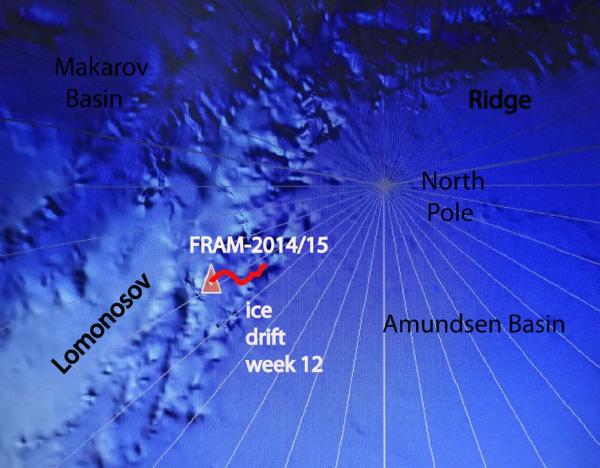
Fig. 1 Drift track of FRAM-2014/15 over Lomonosov Ridge during week 12
Sea ice dynamics
The very appearance of the sea ice surface testifies to the intensity and scales of sea ice dynamics. Polarstern offloaded us on a floe of level ice separated by a long northwest trending lead. The area on the other side of the lead had the appearance of a vast field of ice rubble. Our camp was established about 200 meters away from the lead. Since then, the lead has closed and opened several times. It is our impression that cracking and pressure ridge formation on our floe has gradually moved towards our location from the southeast and this week it consumed our camp.
As we have total darkness, the beam of your head lamp determine the bounds of your micro-cosmos, the rest becomes extra-galactic ice space. The combination of a dynamic ice situation and total darkness give you the feeling of not knowing what is going on, because you lack the overview. A sudden increase in activity on Sunday night widened the lead between the radiation flux instruments and the hovercraft to 15 meters. This lead appears to be perpendicular to the main lead Polarstern used. On its way, the lead graced the front of our line of equipment and food boxes. Subsequently the lead turned into a major shear zone which built piles of ice rubble several meters high. The intensity of deformation peaked on Wednesday. Cracks developed as splays from the shear motion and fragmented a major part of the camp area including where most of the fuel, food and equipment were located (Fig. 2). One crack went through the remains of the ice hangar and the water level on top of the ice in the old storage room increased by another 0.5 meter. The highest priority became moving the fuel bladders in relay by pumping into empty bladders sitting on still unbroken ice and this operation went smooth (Fig. 3). The next challenge was to move more than one ton of food and over 2 tons of equipment. We quickly realized that using the hovercraft as a power plant for the hydraulic geology winch with the 3000 meter of kevlar line, we had a way to pull a load in any direction by use of an anchored extra idler. We had earlier built a sled from a full sheet of coated plywood with a 15 cm. steel pipe forming a curved front. To reduce friction, we sacrificed an empty fuel bladder to line the sled underneath. With these resources, we moved the food and equipment, more than 3 tons in total by about 200 meters in the course of one 25 hour and a subsequent 20 hour work period.
There was nothing one could do except wait and see with regard to instruments like the current meters, the ADCP and the thermistor string suspended from the underside of the ice. Each site had been marked with a 3 meter long plastic pipe which enabled us to monitor the state of the site as ice deformation progressed. The current meter presently at 1050 meter depth, the 300 meter long thermistor string and the radiation flux instruments are on the same ice floe and seem unhurt. At the moment, the big unknown is the situation with the ADCP which is only about 2 meter from the main shear zone where under-thrusted ice is very likely. We will explore the site using a camera, before undertaking the major task of cutting a hole. The radiation flux instrument has since been moved because the site was out of reach for our power cords.
Camp life
Temperatures this week were below - 30° C, except for Wednesday (- 25° C) and during the weekend (- 21° C. The ice activity controlled our minds the whole week. Much agony got into deciding; what should you consider a safe place for the time being, particularly with respect to the bulk of our cargo. At one point on Thursday, we started to carry special equipment items to the store room in the abandoned ice hangar, among them Zarges boxes which belonged to the Meterological Institute and the Geophysical Institute. However, on Saturday, the shear zone encroached on the remains of the ice hangar. The next thing we discovered was another 50 cm of water on top of the ice in the store
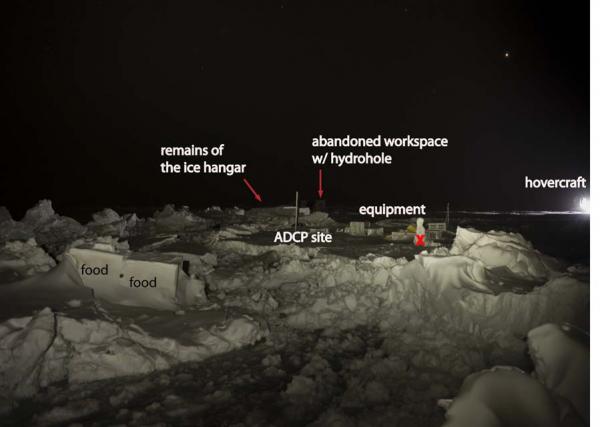
Fig. 2. Overview of part of the camp area on Sunday 23 November. The only woman in town, a snow lady created by the Polarstern scienc crew is marked by a red X.
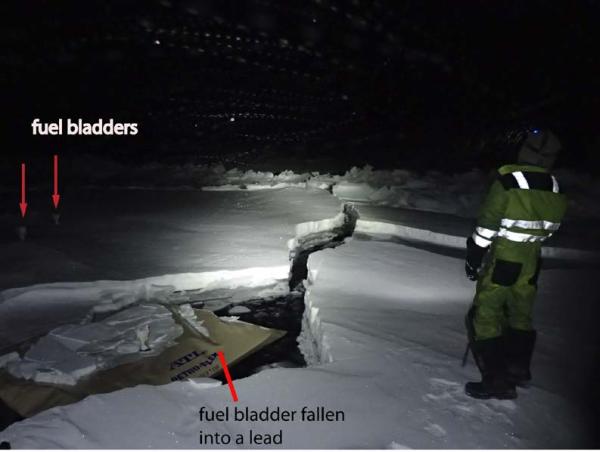
Fig. 3. Fuel bladders before rescue.
room, the boxes were floating around and the walls were caving in - we could not get the boxes out. On Sunday, the destruction was complete. We spotted the boxes in the remains and after some digging were able to pull them out of the icy slush before they were frozen in. Some minor equipment items were lost. This mistaken perception of a "safe place" had limited consequences. However, the more nagging question was: where should the next camp be? Having wandered around with our head lamps in the neighborhood (extra-galactic ice space), we want to move everything another 150 meters, and make it Camp IV.
Coming out of an intense week-long work period in -30° C, we face the reality that first we have to continue cleaning up what is behind us and then start from scratch preparing work facilities for the third time in four months. Also, the ice drift is bringing us back to Lomonosov Ridge, our primary science target which presents new science opportunities that should not be lost. You never win them all, but we will do the best we can.
One lesson from our short stay on the sea ice so far is that the solution for your work facilities should not be ice hangars, but one that is relatively light weight and easy to mobilize and demobilize. A double tent held up by pressurized air beams is one possibility being considered.
Science
This week, the following suite of continuous measurements has been unaffected by the ice activity:
Bathymetry and sub-bottom profiling:
- two active autonomous echo sounder buoys reporting to shore via Iridium
Oceanography:
- Acoustic Doppler Current Profiler 0- 500 meter depth ???
- two Aanderaa current meters at 800 and 1050 meter depth, respectively.
- thermistor string with 30 thermistors from the surface to 300 meter depth.
Atmosphere:
- measurement of incoming and outgoing radiation from the ice surface
- surface infrared skin temperature
- sun time
- Aanderaa weather station (wind, temperature and humidity)
The destruction of our camp area, made it impossible to carry out any additional science tasks during the week.
We have a new visitor. Audun caught the glimpse of a polar fox running across the abandoned camp. The tracks of the animal are shown In Fig 3.
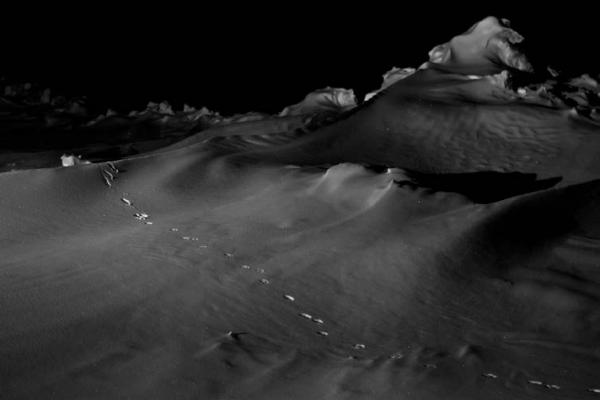
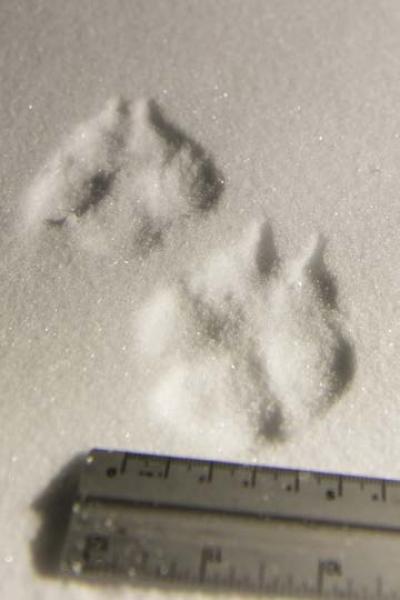
Fig. 3 Tracks of a visiting polar fox
There is hardly a dull moment, and life is treating us well apart from the unpredictable ice dynamics.
Yngve Kristoffersen & Audun Tholfsen
Daily reports
Monday 17 November.
Position: 89° 09.6' N, 57° 53' W, temperature - 34° C, air pressure 1010 hPa, wind 5 knots from NNE. Ice drift 0.1 knots towards south. Shooting seismic reflection, but recovered the airgun in the afternoon. Audun made GPS survey of the leads and pressure ridges in the area of our camp. We inspected the fuel cache and discovered a crack had made a fuel bladder fall into the water. We secured the bladder and pumped all its content into an empty bladder. Started to disconnect the hovercraft, but the skirt control did not respond. As the temperature had fallen to - 34° C, we put heat overnight to warm the hydraulic reservoir.
Tuesday 18 November..
Position: 89° 06,9' N, 57° 03' W, temperature - 38° C, air pressure 1017 hPa, wind 6 knots from ENE. Ice drift 0.1 knots towards south. Skirt control repaired. Had problems getting the hovercraft off the bed created by six weeks of idling in the same spot.
Wednesday 19 November.
Position: 89° 04.2' N, 56° 37' W, temperature - 25° C, air pressure 1017 hPa, wind 12 knots from NE. Ice drift 0.3 knots towards south. The ice activity was very high all day. The lead between the radiation flux instruments and the hovercraft turned into a major shear zone which built piles of ice rubble several meters high. Cracks developed as splays from this shear motion and fragmented a major part of the camp area including where most of the fuel was located. The highest priority became moving the fuel bladders in relay by pumping into empty bladders sitting in still unbroken ice. By early Thursday morning, seven full bladders had been moved. Two were spotted in a pressure ridge and the last two were missing.
Thursday 20 November
Position: 88° 59.4' N, 56° 44' W, temperature - 31° C, air pressure 1020 hPa, wind 10 knots from E. Ice drift 0.1 knots toward south. Emptied and recovered two fuel bladders caught in a pressure ridge. Kept moving the fuel farther away from the active area. Also started moving food and equipment.
Friday 21 November.
Position: 88° 58.4' N, 56° 27' W, temperature - 34° C, air pressure 1027 hPa, wind 7 knots from ESE. Ice drift 0.1 knots towards south. The priority was getting all the food out of the active zone. Used the geology winch to pull a sled to speed up the process. Worked continuously until Saturday noon. Relay pumping of fuel went in parallel with this activity.
Saturday 22 November.
Position: 88° 55.8' N, 60° 54' W, temperature - 21° C, air pressure 1003 hPa, wind 28 knots from E. After resting from 1200 hours to 2000 hours, moving cargo and pumping fuel continued without stop until Sunday at 1500 hours.
Sunday 23 November.
Position: 88° 52.8' N, 62° 32' W, temperature - 20° C, air pressure 996 hPa, wind 4 knots from WSW. Ice drift 0.4 knot towards south. Had to stop working at 1500 hours - we were exhausted. Audun spotted a polar fox. Went to sleep until Monday at 0800 hours.

